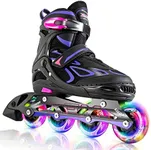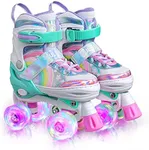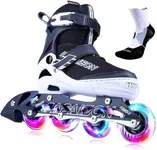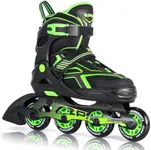Buying Guide for the Best Kids Roller Blades
Choosing the right roller blades for kids is all about ensuring safety, comfort, and fun. The right pair will help your child learn and enjoy skating while minimizing the risk of injury. It's important to consider how your child will use the roller blades—whether for casual play, learning, or more serious skating—and to match the features of the roller blades to their skill level and needs. Always prioritize fit and safety features, as these will have the biggest impact on your child's skating experience.Size AdjustabilitySize adjustability refers to the ability of the roller blades to change in size, usually by a simple mechanism that allows the boot to expand or contract. This is important because kids' feet grow quickly, and adjustable skates can be used for several seasons, saving you from frequent replacements. Adjustable skates typically come in ranges (for example, sizes 1-4 or 2-5). For younger children or those with fast-growing feet, a wider range is helpful. For older kids or those with more stable shoe sizes, a smaller range may be sufficient. Choose adjustability based on how long you want the skates to last and how quickly your child's feet are growing.
Wheel Size and HardnessWheel size and hardness affect how the roller blades perform. Smaller wheels (around 64-72mm) are slower and more stable, making them ideal for beginners and younger kids. Larger wheels (above 72mm) are faster and better for more experienced skaters. Wheel hardness is measured in 'A' (like 82A), with lower numbers being softer and grippier, which is good for indoor or smooth surfaces, while harder wheels last longer and are better for outdoor use. Consider your child's skill level and where they will skate most often when choosing wheel size and hardness.
Boot Support and PaddingBoot support and padding refer to how much structure and cushioning the skate provides around the foot and ankle. Good support helps prevent injuries and makes skating more comfortable, especially for beginners. Skates with more padding and a higher cuff offer better ankle support, which is important for new skaters or those who need extra stability. As kids become more skilled, they may prefer a lighter, less padded boot for better movement. Match the level of support to your child's experience and comfort needs.
Closure SystemThe closure system is how the roller blades are fastened to the foot, such as laces, Velcro straps, buckles, or a combination. A secure closure keeps the foot stable and prevents slipping inside the boot. Younger kids often benefit from simple systems like Velcro or buckles, which are easy to use and adjust. Older kids or those with more experience might prefer a combination of laces and buckles for a snugger fit. Choose a closure system that your child can manage independently and that keeps their foot secure.
Brake TypeMost kids' roller blades come with a heel brake, which is a rubber stopper attached to the back of one skate. This is important for safety, as it helps kids stop easily. Some advanced skates may not have a brake, but for most children, especially beginners, a heel brake is essential. Make sure the skates you choose have a reliable brake, and teach your child how to use it properly.
Weight of the SkatesThe weight of the roller blades affects how easy they are to use. Lighter skates are easier for kids to maneuver and less tiring to wear, especially for younger or smaller children. Heavier skates can be more durable but may be harder to control. Consider your child's age, size, and strength when choosing the weight of the skates—lighter is usually better for beginners.















